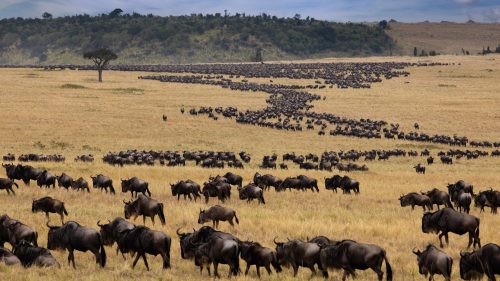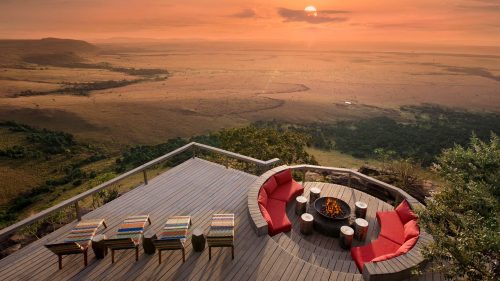Early this week, the ever so dazzling Nadallah playfully demonstrated her superb skills as she nimbly jumped from branch to branch. Over the last few weeks, rather unusually, she has been killing servals, but this time she had a reedbuck kill stashed high, far away from prying hyenas and other predators.
We caught up with the Swamp Lioness and her three cubs as they were hurriedly heading back to the marshy area of the Mara River. Judging by their full stomachs, they were probably coming from a feast. The last time we saw them was the 25th of March — we are so happy that they are all perfectly healthy and still together. The Swamp Lioness usually flies solo but this time, there was another young female tailing them. We are not sure yet who she is. Perhaps one of the missing Angama Pride?
We have a new male cheetah in the Triangle who was first spotted in July this year according to Elene of the Mara-Meru Cheetah Conservation Project. He seemed completely unfamiliar with his surrounding on the edge of Mara River in the Triangle as we watched him try and cross the river several times (he eventually made it). We hope he likes what he sees and decides to stick around.
The Mara Triangle is home to an impressive black rhino population, but you are not always guaranteed to spot one during drives. This species, which is more aggressive than its white counterpart, is a solitary animal and the only strong bond is between a mother and a calf. We were lucky to see this in action as we came across these two early one morning.
The old guard continues to defy the odds and keep pushing on. Way past his prime, the Shepherd Tree Male's body seems to have shrunken a bit and even his gait has changed. Occasionally, he hunts easy prey or whatever is easily available which, at the moment, is wildebeest. He had dragged this one up underneath a large boulder giving him excellent privacy. It is good to see him making a decent meal of a young wildebeest as every kill provides life-giving nutrients and strength to his ageing body.
At long last, we had some good rains at the beginning of the week. While we are relieved it stopped the dust from kicking up on the roads, it didn't please everybody. Wildebeest seem to be avoiding touching water after their first traumatic crossing of the Mara River and Chongo of the Bila Shaka coalition prefers not to get wet — he is just a giant cat after all.
The River Pride are making the most of the current season of plenty with three wildebeest kills at one sitting. Their cubs are looking very healthy (if you ignore the mud and gore) and are very playful. Life is good when you're under the protection of the Bila Shaka males.
This opportunistic hyena stumbled upon a partially eaten wildebeest carcass and decided to gorge on it, not realising that new owners had already claimed it. It wasn’t a big predator lurking nearby in the grass but actually the smallest cleaners of the savannah: siafu, or safari ants. Every time the hyena tried to take a bite out of the carcass, the ants would attack his nose and mouth making for a very uncomfortable meal.

The wildebeest herds have already started to move towards the Serengeti, but this time last year, they were happily munching on the lush grass in the Triangle. Hopefully, the rain will convince them to spend a little bit more time with us in the Triangle.
Filed under: This Week at Angama
Subscribe for Weekly Stories
Comments (0):

Angama Image Gallery